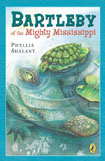Bartleby of the Mighty Mississippi
by Phyllis ShalantInterview with Phyllis Shalant
Jacqueline: You have said that you had a pet turtle when you were a child. Is that how you decided to write a story about a turtle as the main character? If not, how did you come to that decision?
Phyllis: While getting my M.A. at Manhattanville College, I signed up for a class in writing fantasy. It was taught by Patricia Lee Gauch, who is a superb editor as well as teacher. At the time, we were reading 'high fantasy'-- the kind that has to do with the battle between good and evil forces for the future of the world. One morning, I was walking along a river near home, casting around for an idea, when I saw a large red-eared turtle sunning itself on a branch that had fallen into the water. I couldn't help wondering how it had gotten there. Suddenly, I was like a time-traveler, whisked all the way back to my childhood days with my pet red-ear. That afternoon, I began writing Bartleby of the Mighty Mississippi. In my story, the world wasn't at stake, but rather, the future of a young turtle who sets out to discover the world and his place in it.
Stephanie: How is the creative process of writing a fantasy different from that of writing a work of realistic fiction?
Phyllis: I seem to go back and forth between realistic fiction and fantasy pretty easily. I think it's because as a child I frequently slipped between the real world and the magic world. I say "magic " rather than "imaginary, " because for me, the experience was different than just making things up. There was a part of me that believed a doll had feelings, that I might be able to fly if I kept on trying, and that the old lady down the street was a real witch with a cauldron in the kitchen. I was always looking for signs and clues. I'm sure there are a lot of children with a similar sensibility. My book, When Pirates Came to Brooklyn, which is partly autobiographical, describes such a child.
Jacqueline: Some authors think through a whole story in their head before they begin to write it. What is your thought/writing process, or the thought/writing process you used when writing Bartleby?
Phyllis: I like to work in a loose way. I start with an idea for a story and some of the characters, but I don't outline or work things out in advance. My creative process involves a gradual dawning of ideas. It often feels as slow as evolution itself, but in order to do my best work, I must allow everything to stew.
Stephanie: Could you describe your experience with the editing process?
Phyllis: I really value my editor's take on what I write. Her comments and suggestions help me to see things in the story I may not have noticed. But before I ever show her a draft, I spend a lot of time editing myself. For me, the process of revision is as important as writing the initial story. By the time I've finished a first draft, I understand my characters a lot better--what's important to them, and what their reactions to various situations might be. The more real they become, the more capable they are of surprising me. While writing Bartleby of the Big Bad Bayou, the sequel to the first book, I had that experience with an alligator named Number Four. I'd always thought of him as a morally ambiguous character, but at the end of the story he did something totally unexpected that showed me his true colors.
Jacqueline: Your animal characters seem to become human in Bartleby. In creating humanistic characters did you create the animals after people you know or have seen, or did you think of specific animal traits that you could humanize for the story?
Phyllis: I attempted to make my characters' personalities true to their species by doing tons of research on turtles, alligators, frogs, ducks, snakes, and other creatures. For example, Mudly is a rather grumpy loner because he's accustomed to other creatures' negative reaction to his smell. But in writing about how Bartleby makes the transformation from pet to "wild turtle, " I was also thinking about how a child learns and grows as he or she navigates the world outside home. That is where the human qualities come into play.
Jacqueline: Who is your favorite character in Bartleby of the Mighty Mississippi, and why?
Phyllis: I love Bartleby dearly because he has so many of the qualities I appreciate in children--innocence, a sense of wonder, curiosity, sensitivity to the feelings of others, and the determination to learn and grow.
Stephanie: Which character was the most challenging to write in Bartleby of the Mighty Mississippi? Why?
Phyllis: Seezer was the toughest. I didn't get him "right " at first. My editor urged me to keep his motives more ambiguous--Did he want to eat Bartleby, or not? I struggled until I found the key to Seezer's personality-- his pride. An alligator in a pond or bayou is like a lion on his home turf. He is a proud king. He can't admit to fear or need. He can't seem too kind. Yet inside, his heart is as big as the landscape. When those he cares about are threatened, he will put himself at risk to protect them.
Stephanie: If you could impart only one piece of advice to aspiring authors, what would it be?
Phyllis: Because I've taught writing to both adults and kids, I've thought about this a lot. I think it's the reason I'm not capable of offering only one piece of advice. But I've narrowed it down to four suggestions I think aspiring writers might find useful.
1. Choosing the right story is the most important decision you'll make. If possible, choose the story you're absolutely dying to tell. Your enthusiasm for your subject will come through in your piece and win readers over to your side.
2. Look in your own backyard. Every one of us has had experiences that make wonderful stories.
3. Take risks in your writing. Be willing to expose your heart. Write about things that really matter, even if it hurts a little.
4. Be open to revising. Don't be afraid to make changes in plot and character. Many professional writers consider revising the most important part of their work.
Stephanie: Have you ever experienced "writer's block"? If so, how did you resolve the problem? If not, how do you think you avoid it?
Phyllis: Sometimes I think I suffer from the opposite of writer's block-- writer's overflow. It sounds like a joke, but it can be frustrating when you can't write fast enough to keep up with the ideas. But with every book, there are problems to solve. Sometimes I can't figure out how to make a thing happen, or I don't like the direction a story is taking. I've found several ways to get myself moving again. One is to read something I admire very much. Another is to take a break and do something else-- I'll go for a walk, cook something interesting, or work in the garden a bit. But if I'm stuck for too long, I know I have to go back and look at the basics: What does the main character want? What is the chief conflict? How will it be resolved? The answers to those questions can help me get back on track.
1. Schedule a visit to the school library and or computer lab so that students can research red-eared turtles. Provide them with an outline format or make suggestions that they seek information about the habitat, physical characteristics, diet, behavior, and predators/prey of red-eared turtles.
2. Research southern bayous and northern ponds. Where are they found? What types of plants, animals, insects, and fish life are found in these two bodies of water? Compare and contrast a bayou and a pond. How are they different? How are they the same?
3. Have the children research the author as well as other stories she has written at www.Phylisshalant.com.







